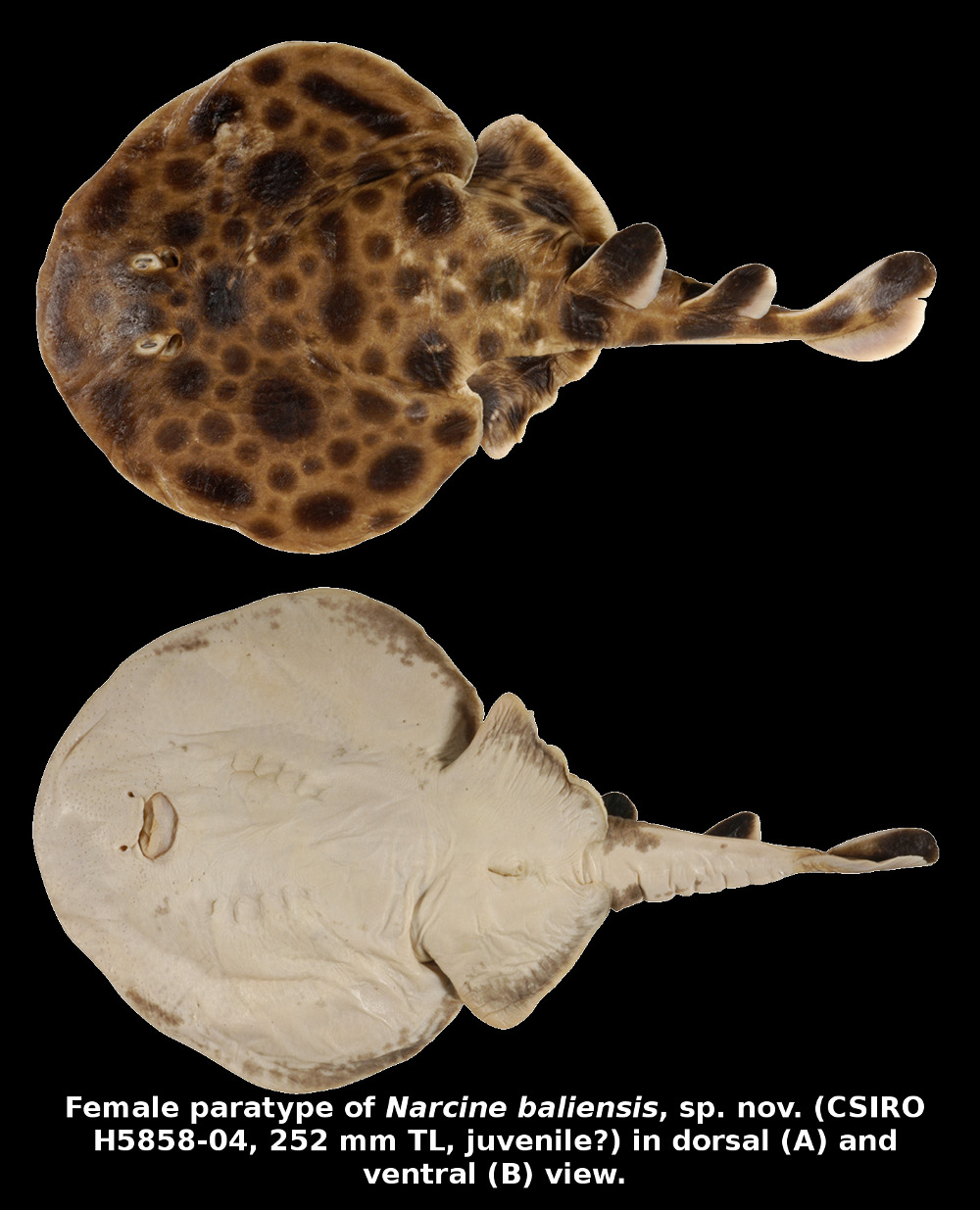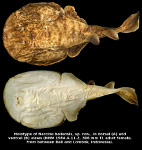Narcine baliensis
De Carvalho & White, 2016
Classification: Elasmobranchii Torpediniformes Narcinidae
Reference of the original description
Narcine baliensis, a new species of electric ray from southeast Asia (Chondrichthyes: Torpediniformes). Zootaxa, 4127(1), 149–160
Narcine baliensis, a new species of electric ray from southeast Asia (Chondrichthyes: Torpediniformes). Zootaxa, 4127(1), 149–160
Types
Narcine baliensis
Holotype: BMNH: 1984.4.11.2; Paratype: CSIRO: H 5858-04; CSIRO: H 5858-03; MZB: 23016;
Narcine baliensis
Holotype: BMNH: 1984.4.11.2; Paratype: CSIRO: H 5858-04; CSIRO: H 5858-03; MZB: 23016;
Description :
Citation: Narcine baliensis De Carvalho & White, 2016: In: Database of modern sharks, rays and chimaeras, www.shark-references.com, World Wide Web electronic publication, Version 01/2026
Please send your images of "Narcine baliensis" to info@shark-references.com

Female paratype of Narcine baliensis, sp. nov. (CSIRO H5858-04, 252 mm TL, juvenile?) in dorsal and ventral view. © DE CARVALHO & White, 2016

Female paratype of Narcine baliensis, sp. nov. (CSIRO H5858-04, 252 mm TL, juvenile?) in dorsal and ventral view. © DE CARVALHO & White, 2016
Short Description
Original diagnosis after DE CARVALHO & WHITE, 2016 [24257]: A species of Narcine distinguished from congeners by its unique dorsal color pattern, composed of large, circular, ovoid or elongate dark brown blotches on dorsal disc, interspersed with more numerous small (about eye-sized or greater) brownish, circular to ovoid spots, with large and small spots and blotches surrounded by a very slender creamy-white pattern, on a light brown to tan background color. Narcine baliensis is distinguished from N. brevilabiata and N. atzi, species that also possess few large brownish spots or blotches and numerous smaller spots, by having much fewer small spots or blotches, and by having the creamy-white, slender outline surrounding large and smaller spots and blotches on dorsal mid-disc. Additionally, N. baliensis is distinguished from N. brevilabiata by having much fewer small dark spots, and tooth bands of subequal width that are broadly circular in outline (vs. many small dark spots, and strongly subtriangular tooth bands, with upper tooth band clearly wider than lower tooth band in N. brevilabiata), and from N. atzi by having fewer smaller spots, and dorsal fins subequal in height and length of base or first dorsal fin just slightly greater than second (vs. more numerous small spots, smaller than eye-diameter, and first dorsal fin conspicuously greater and with longer base than second dorsal fin in N. atzi). Narcine baliensis is also distinguished from the Indo-West Pacific and Indian Ocean species N. maculata, N. lingula and N. prodorsalis, by having the preoral distance greater than preorbital distance (about equal in former three species); and from the western Indian Ocean N. oculifera and N. insolita, N. baliensis is further distinct in having dorsal fins of subequal size (first dorsal fin much larger than second in N. oculifera and N. insolita).
Original diagnosis after DE CARVALHO & WHITE, 2016 [24257]: A species of Narcine distinguished from congeners by its unique dorsal color pattern, composed of large, circular, ovoid or elongate dark brown blotches on dorsal disc, interspersed with more numerous small (about eye-sized or greater) brownish, circular to ovoid spots, with large and small spots and blotches surrounded by a very slender creamy-white pattern, on a light brown to tan background color. Narcine baliensis is distinguished from N. brevilabiata and N. atzi, species that also possess few large brownish spots or blotches and numerous smaller spots, by having much fewer small spots or blotches, and by having the creamy-white, slender outline surrounding large and smaller spots and blotches on dorsal mid-disc. Additionally, N. baliensis is distinguished from N. brevilabiata by having much fewer small dark spots, and tooth bands of subequal width that are broadly circular in outline (vs. many small dark spots, and strongly subtriangular tooth bands, with upper tooth band clearly wider than lower tooth band in N. brevilabiata), and from N. atzi by having fewer smaller spots, and dorsal fins subequal in height and length of base or first dorsal fin just slightly greater than second (vs. more numerous small spots, smaller than eye-diameter, and first dorsal fin conspicuously greater and with longer base than second dorsal fin in N. atzi). Narcine baliensis is also distinguished from the Indo-West Pacific and Indian Ocean species N. maculata, N. lingula and N. prodorsalis, by having the preoral distance greater than preorbital distance (about equal in former three species); and from the western Indian Ocean N. oculifera and N. insolita, N. baliensis is further distinct in having dorsal fins of subequal size (first dorsal fin much larger than second in N. oculifera and N. insolita).
Size / Weight / Age
female mature at 306 mm TL, largest male specimen is a juvenile 160 mm TL (types) [24257]
female mature at 306 mm TL, largest male specimen is a juvenile 160 mm TL (types) [24257]
Dentition
Upper exposed tooth band slightly wider than lower exposed tooth band; both tooth bands broadly circular in outline, much wider than long. Teeth very small and numerous, in 26/21 vertical exposed rows in holotype. Teeth with small cusps even on inner, non-exposed tooth rows; teeth with posteriorly rounded, rhomboidal bases. [24257]
Upper exposed tooth band slightly wider than lower exposed tooth band; both tooth bands broadly circular in outline, much wider than long. Teeth very small and numerous, in 26/21 vertical exposed rows in holotype. Teeth with small cusps even on inner, non-exposed tooth rows; teeth with posteriorly rounded, rhomboidal bases. [24257]
Remarks
shark-references Species-ID=14602;
shark-references Species-ID=14602;



















